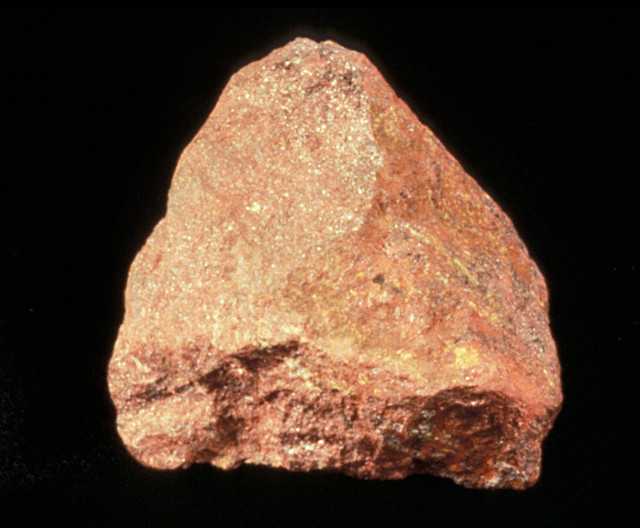
by U.S. Geological Survey Wednesday, June 13, 2018
William E. Brooks, a mineral commodity specialist for the U.S. Geological Survey, compiled the following information about mercury, a mineral commodity used in industrial and small-scale gold mining applications.

Cinnabar is the most important ore of mercury. Credit: U.S. Geological Survey, ESW Image Bank
Since at least Roman times, mercury has been used for amalgamation with gold. The Romans used mercury from cinnabar — the most important ore of mercury — from Almadén, Spain, home to the world’s oldest producing mercury mine. That use continued through the Middle Ages and the Colonial era. Mercury from Almadén was used mainly for Spanish colonial silver processing in the New World until the discovery of rich cinnabar deposits at Huancavelica, Peru, which provided a regional source for the vital metal. The Spanish site is still important. Since 1927, in conformance with the system used at Almadén, the “flask” has been the unit for measuring and pricing mercury. One flask weighs 34.5 kilograms; 29 flasks are contained in a metric ton.
Cinnabar, a soft and dark red mineral, is associated with epithermal mineral deposits. It occurs in fine-grained or brecciated sedimentary and volcanic rocks near hot springs or volcanic centers, from where it can be mined. Mercury also is recovered as a byproduct of copper, gold, lead-zinc, or silver processing.
In the U.S., mercury is either produced as a byproduct of precious metals mining, mainly in Nevada, or it is reclaimed and recycled from a wide variety of sources, including automobile convenience switches, batteries, contaminated soil, compact and traditional fluorescent lamps, computers, dental amalgam, gym flooring, medical devices and thermostats.
Mercury amalgamates readily with silver and gold, and has been used for small-scale gold mining in West Africa, Colombia, Peru, Turkey and many other parts of the world. The largest-scale use of mercury, however, is as an electrolyte in the production of industrial chlorine and caustic soda. Mercury also has a long history of use for other industrial, medical and mining applications, but because of its effects on human health, its continued use is in question. Non-mercury substitutes are available. For example, digital thermometers have widely replaced mercury thermometers, and ceramic materials are substituted for mercury in dental amalgam.
In the early 1990s, U.S. manufacturers used 500 to 600 metric tons per year of recycled and imported mercury; that amount has now declined to less than 50 metric tons per year. The average U.S. domestic price of mercury was $150 per flask from 2000 to 2003, but the price is now between $2,000 and $3,000 per flask. This dramatic change has resulted from limited availability of mercury from recycled sources; international environmental and human health concerns and bans on mercury use; and an increase in the price of gold, specifically gold produced by small-scale methods that rely on amalgamation for gold recovery.
For more information on mercury, visit http://minerals.usgs.gov/minerals.
Mercury production and consumption
Mercury has not been mined as a principal product in the United States since 1992.
The U.S. consumed less than 50 metric tons of mercury in 2011.
World mercury mine production was estimated to be 2,010 metric tons in 2011.
In 2011, China (1,500 metric tons) and Kyrgyzstan (250 metric tons) were the top producers of mined mercury, and Chile (100 metric tons) and Peru (35 metric tons) were the top producers of byproduct mercury.
Fun facts
Mercury is the only metal that is liquid at room temperature.
Mercury’s atomic symbol, Hg, comes from “hydrargyrum,” the ancient Greek word meaning liquid silver.
The silvery, liquid metal mercury was known to Aristotle in the fourth century B.C. In A.D. 55, Pliny the Elder recommended that those who polish cinnabar, the ore of mercury, use masks to cover their faces because inhalation of the dust was a serious health hazard.
A mercury compound was used to produce hats in 18th-century England; exposure to the fumes led to a nervous disorder termed “Mad Hatter’s disease” and to the phrase “mad as a hatter.”
© 2008-2021. All rights reserved. Any copying, redistribution or retransmission of any of the contents of this service without the expressed written permission of the American Geosciences Institute is expressly prohibited. Click here for all copyright requests.